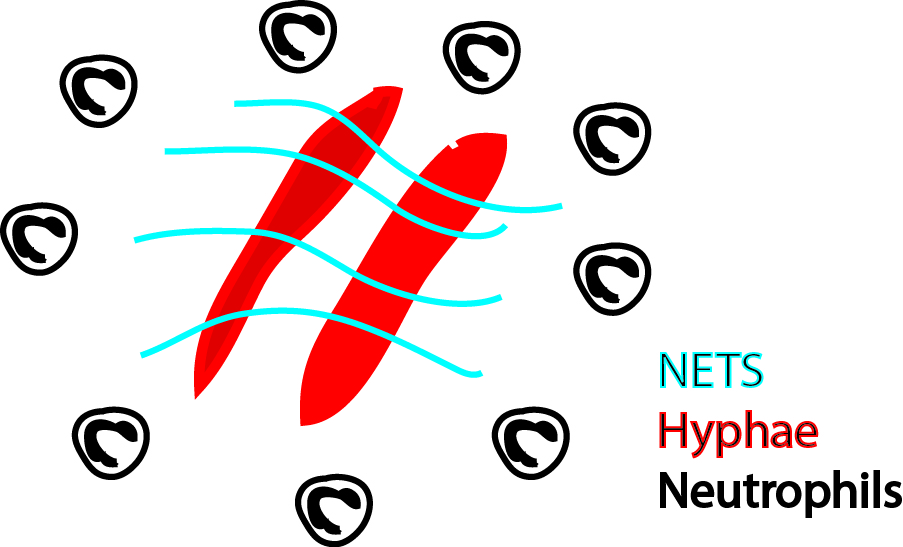Written by Dhiren Patel
Edited by Judith Secklehner and John Mackey
We recently had the pleasure of attending a great seminar by Dr. Venizelos Papayannopoulos of the Francis Crick Institute titled “Decision making neutrophils in antimicrobial responses”.
He introduced the audience to Neutrophil Extracellular Traps (NETs) which are large web-like structures consisting of neutrophil cellular components post necrosis. NETs consist primarily of histones but also contain a large proportion of the potent arsenal of granular components that neutrophils commonly utilise to kill and digest pathogens.
Dr. Papatannopolous then introduced us to the first of 2 papers he discusses in the seminar titled “Neutrophils sense microbe size and selectively release neutrophil extracellular traps in response to large pathogens1”.
It has been well characterised that fungi considerably change in size during different stages of its life cycle and this provides a unique challenge to our immune system when tackling this pathogen. While neutrophils can readily phagocytose fungi in its smaller yeast form, this critical immune process is inefficient when fungi exist in its larger filamentous hyphae form.
With the discovery of NETs, little was known how neutrophils selectively provide immunity by undergoing phagocytosis or NETosis. The authors therefore speculated that NETosis may be important in killing larger pathogens that are unable to be phagocytosed such as the larger filamentous hyphae form that fungi exist in.
The paper showed that neutrophils selectively provided antimicrobial immunity depending on the size of pathogens. This was shown using the fungus, Candida albicans in different stages of its life cycle. They showed that Candida in its smaller yeast stage was readily phagocytosed by neutrophils however, Candida in its larger hyphae stage triggered selective NET formation when cultured with neutrophils. They further went on to prove that pathogen size does indeed matter by fragmenting the hyphae which unequivocally favoured phagocytosis.
Upon exploring the mechanism in which neutrophils selectively undergo phagocytosis or NETosis, the group uncovers that the molecule, Dectin-1 is critical in determining the selective anti-microbial strategy of whether neutrophils shall undergo phagocytosis or NETosis. Dectin-1 was shown to be critical in promoting phagocytosis and when Dectin-1 was inhibited, it induced aberrant NET formation from neutrophils. It is believed that Dectin-1 may function in the translocation of Neutrophil Elastase to the membrane which encourages phagocytosis.
The second paper discussed was Dr. Papayannopoulos’s most recent paper, “Neutrophil extracellular traps license macrophages for cytokine production in atherosclerosis2”. Here he shows that neutrophils readily form NETs when they encounter cholesterol crystals and NETs were readily found in atherosclerotic plaques. Interestingly, they observed that mice lacking the ability to produce NETs not only displayed significant reductions in lesion sizes but presented with reductions in concentrations of IL-1β, a key macrophage-derived cytokine critical to plaque formation. This suggested that NETs possibly may promote cytokine production from cells within the lesion such as macrophages. They further proved this by culturing macrophages with NETs and observed augmented caspase-1 and IL-1β formation.
The molecular basis of this NET-induced ‘macrophage priming’ remains to be elucidated but what has been uncovered is that NETs can self- maintain neutrophilic inflammation by triggering macrophages to release IL-1 β which in turn was shown to drive Th17 recruitment and consequentially increased concentrations of cytokine IL-17.
 This seminar introduced us to a novel concept of neutrophil biology in which neutrophils utilise different strategies to provide immunity. It may also serve as an important reminder against the current perception that neutrophils are not just ‘suicidal killers’ but can also elegantly and intrinsically shape many facets of the immune response such as priming macrophages to release IL-1β in atherosclerotic plaques.
This seminar introduced us to a novel concept of neutrophil biology in which neutrophils utilise different strategies to provide immunity. It may also serve as an important reminder against the current perception that neutrophils are not just ‘suicidal killers’ but can also elegantly and intrinsically shape many facets of the immune response such as priming macrophages to release IL-1β in atherosclerotic plaques.
Papers:
- Branzk, N. et al. Neutrophils sense microbe size and selectively release neutrophil extracellular traps in response to large pathogens. Nat. Immunol. 15, 1017–25 (2014).
- Warnatsch, A., Ioannou, M., Wang, Q. & Papayannopoulos, V. Inflammation. Neutrophil extracellular traps license macrophages for cytokine production in atherosclerosis. Science 349, 316–20 (2015).